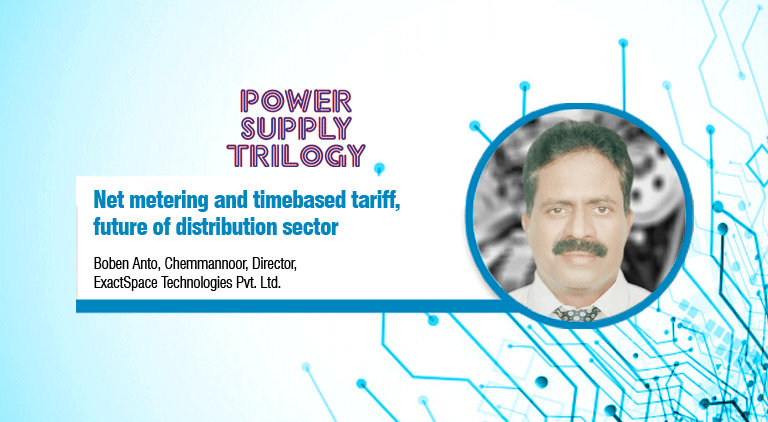Net metering and timebased tariff, future of distribution sector
By EPR Magazine Editorial November 18, 2019 12:35 pm IST
By EPR Magazine Editorial November 18, 2019 12:35 pm IST

The variable pay costs prescribed in UDAY 1.0 and UDAY 2.0 will increase the market image, and the people will start making optimal usage of electricity as and when required.
Boben Anto Chemmannoor, Director, ExactSpace Technologies Pvt. Ltd., in a conversation with Megha Iyer of EPR discusses various ways for the upliftment of distribution and transmission sector and minimising the losses incurred by the DISCOMs.
Improving distribution gap
Unfortunately, the distribution structure of Indian power sector is not apt. DISCOMs are giving away lot of subsidiaries because of which the concept of net metering is not falling in place. These issues have adversely affected DISCOMs’ health and wealth, and as a result the structural improvement of this sector, it could flourish itself out only in a few selected states.
Till now we had LT meters installed across various cities, whereas, some of the metro cities today have metering systems of 20 kv, 32kv and 11 kv. With application of these varied metering systems, the cost of power purchase and other related power tariffs went too low. Today, most of the companies are already having PPA to ensure effectiveness in their systems, because of which the average cost of selling and cost of power purchase was not matching and this aspect has improved the distribution gap.
Considerably, the losses were incurred by the distribution section 5 years ago, as people and companies have nullified the subsidiary as distribution losses. The situation has changed now to the domical improvement of collection v/a supply. Currently, we have a structure with 50 years of time, here we can find distribution transformers, distribution network, and open network which are unhealthy and are open to be affected by the atmospheric conditions and other losses unlike other countries. They have safeguarded their systems so as to meet the power requirements on immediate basis. If you think of addressing this gap in distribution gap financially, you will require a huge investment, which according to a World Bank report is of approximately `80,000 crores. But the unreliability of the distribution leads to excess power of a generator, but markets opportunity for the other small generators.
Power schemes to change debt value into positive
A couple of schemes like UDAY 1.0, UDAY 2.0 and Urja are drafted by the Government of India to curtail the distribution losses and for the betterment of DISCOMs and the power sector. UDAY 1 and UDAY 2.0 are intended at capitalise the debt and convert them into zero debt. With these inventions, the Power
Ministry is trying to convey that such schemes will change the debt value into positive and will become bankable.
The recent incidents of flood and other calamities has increased the investment demands, and because of these investments the states were able to stablise their power distribution and generation network, and the best example is Chattisgarh State, which is constantly maintaining a positive outlook throughout. Basically, the distribution price should be planned and agreed on long term only then the power supply can be concurrent and efficient. If there are indifferences in the hydel load and the industrial load, distribution collection becomes deteriorated. Most of the companies are upon the solar and wind energy, are sustainable because the impact of coal prices hasn’t affected them and hence a bankable book will come to them.
Implemeting time-based tariffsIndia is scheduled with multi-linked off day system, where there will be no holidays for power generation. The cost of environment will build the cost of power; so unless we increase the power purchase, we won’t be able to sell the power. The variable pay costs prescribed in UDAY 1.0 and UDAY 2.0 will increase the market image2 and the people will start making optimal usage of electricity as and when required.
Diverting the operational system into a special line and not on the internet line
Except smart metering and smart cities, nothing can be so alarming for the cyber systems, as all our grids are about distributing price and availability, not about the distribution pattern. Even today, we don’t have automatic switching or automated grid control system, but with the concept of smart cities we can create a fake meter among the available thousands of meters which will be a biggest concern for me. The fake meter amidst the actual ones, can expose one to cyber attack.
We all are aware of the ‘California Syndrome’, which can be averted by diverting the operational system into a special line and not on the internet line, so the power line will lead to that system further averting any kind of cyber attack. If the controllers of a smart city or a smart grid are protected properly there will be least or no chances of cyber breach. National grid and power grid are operated via separate systems like the internet protocol systems. IP protocol provides with a cloud based systems only for monitoring purpose.
Need for a heavy network transmission pattern
We should get a heavy network transmission pattern. Because we have been severely affected by the cyclone and other natural calamities and are facing a major concern of system defang. We must believe in having connected cable connected underground system, where house supply will be on cable, and rest major supply will be via underground cable which will reduce the aftereffects created by a calamity.
Secondly, our transmission losses are directly proportional to the voltage level, based on the load and criteria; we should have a multi-voltage level metering system. Thirdly, we must have a conditional monitoring and predictive maintenance systems so as to analyse, predict and survive the failure.
Boben Anto Chemmannoor, Director, ExactSpace Technologies Pvt. Ltd.
We use cookies to personalize your experience. By continuing to visit this website you agree to our Terms & Conditions, Privacy Policy and Cookie Policy.